Key Points:
- The eruption of Mount Tambora in 1815 had a significant impact on global climate and agricultural commodities, causing a shortage of agricultural products and a rise in prices.
- The US experience during the Year without a Summer in 1816 was less catastrophic compared to Europe, but it still led to farmers selling their land and heading west for better opportunities.
- The combination of increased land purchases and higher crop prices following the eruption created a boom in the real estate market, but it eventually led to a collapse in land values and financial ruin for many farmers.
On 10 April 1815, Mount Tambora, a volcano on the Indonesian island of Sumbawa, experienced the largest volcanic eruption in recorded history. The eruption caused massive devastation and claimed many lives. However, the eruption’s impact on the climate was even more severe and disruptive. The volcano released a massive cloud of sulfur dioxide into the upper atmosphere, leading to a temporary cooling effect on the planet.
The cooling effect reached its peak in the summer months of 1816, which became known as the Year without a Summer. The decrease in temperature had a devastating impact on crop yields worldwide, leading to a shortage of agricultural commodities and a sharp increase in prices, particularly for wheat and cotton.
In Europe, the impact was especially harsh, and countries had to increase their imports to feed their populations. In the United States, the New England region suffered the most due to the harsher effects of cold weather in the northern latitudes. As a result, many US farmers sold their land and moved westward, attracted by the opportunity to purchase larger tracts of farmland and take advantage of the higher crop prices. The combination of increased land purchases and higher crop prices appeared to be a win-win situation.
However, the real estate boom fueled by the aftermath of the Mount Tambora eruption eventually led to a collapse in land values and financial ruin for many farmers. The decline in agricultural commodity prices caused a global supply glut, leading to plummeting prices. By 1820, wheat prices had fallen by approximately 60% compared to 1817. The Second Bank of the United States, which began operations in 1817, further exacerbated the economic contraction by tightening its lending policies to preserve its reserves.
The combination of falling commodity prices, collapsing land values, tight monetary conditions, and highly indebted landowners contributed to the Panic of 1819, often referred to as the first Great Depression in the United States.
Key Lesson 1: The Danger of Herd Behavior
One of the key lessons from the 1819 real estate bubble is the danger of herd behavior in investing. Humans have a natural instinct to follow the crowd, which was critical for survival in early human history. However, when it comes to investing, following the herd often leads to a price bubble that eventually bursts. Retail and institutional investors who pile into popular investments often suffer the consequences when the asset’s price exceeds its fundamental value.
Key Lesson 2: The Danger of Fighting the Current of Time
Investors who try to cheat the flow of time by seeking quick and significant returns often end up disappointed. Successful investing requires patience and an understanding that it is a long-term process. Trying to compress the time required to turn a small investment into substantial wealth often leads to financial ruin, as witnessed in past asset bubbles.
Key Lesson 3: Considering Alternative Tactics to Buy Time
While the eruption of Mount Tambora brought significant challenges, it also offers potential solutions. The eruption’s impact on climate and crop yields demonstrates the potential effectiveness of solar radiation modification (SRM) to mitigate the effects of climate change. Although it is a controversial and extreme proposition, replicating the effects of a major volcanic eruption by releasing sulfur dioxide into the upper atmosphere could potentially cool the planet on a relatively short timescale. However, the logistics, feasibility, and potential side effects of such a project need careful consideration.
The eruption of Mount Tambora more than 200 years ago still holds valuable lessons for investors today. Understanding the dangers of herd behavior, aligning investment behavior with the flow of time, and considering alternative tactics to address pressing issues can help investors navigate the complexities of the financial markets.







